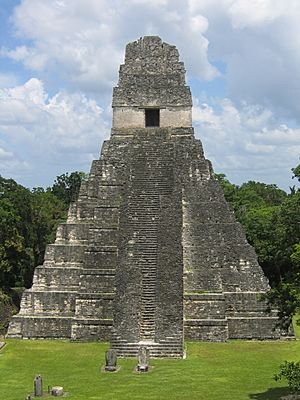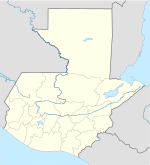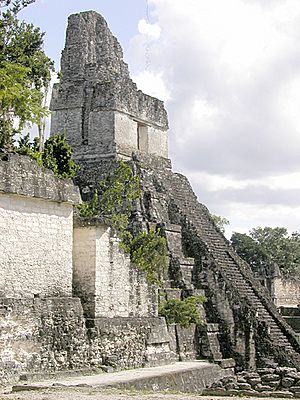Tikal Temple I facts for kids
Tikal Temple I is a famous building at Tikal. Tikal was one of the biggest cities of the ancient Maya civilization. It was located in Mesoamerica, a region in Central America. You can find it in northern Guatemala, in an area called the Petén Basin.
People also call it the Temple of the Great Jaguar. This is because a special wooden carving, called a lintel, shows a king sitting on a jaguar throne. Another name for it is the Temple of Ah Cacao, named after the ruler buried inside. Temple I is a pyramid made of limestone. It has many steps, like a giant staircase. It was built around the year 732 AD.
This temple is part of a World Heritage Site. It has a special roof comb on top. This is a tall, decorative part common in Maya architecture. Building Temple I on the east side of the Great Plaza was a new idea. Before, Maya temples for burials were usually built north of the plaza.
Contents
Exploring the Temple's Design
This temple was built as a burial place for Jasaw Chan Kʼawiil I. He was a powerful ruler of Tikal during the Classic Period. He ruled from 682 AD to 734 AD. Archaeologists found his tomb deep inside the pyramid. The tomb was built first, and then the temple was built over it.
Who Built the Temple?
Jasaw Chan K'awiil's son, Yik' in Chan K'awiil, oversaw the building. Jasaw Chan K'awiil likely planned the temple long before he died. The temple has nine stepped levels. These levels might represent the nine levels of the underworld in Maya beliefs. The temple also has special grooves and corners. A very steep staircase goes up the front to the small temple building at the top.
Temple Height and Features
The temple stands about 55 meters (180 feet) tall above the Great Plaza. A small shrine sits on top of the pyramid. This shrine holds beautifully carved wooden lintels. Jasaw Chan K'awiil probably planned these carvings for his own burial monument.
The lintels were made from sapodilla wood. This wood is very hard and reddish-brown. It was found in the local area. One of the lintels, called Lintel 3, was once painted red. The lintels were made from planks of wood placed in small spaces in the walls. The outer lintel was smooth. The middle lintel was carved with many details from four planks.
Two of these carved planks were taken in the 1800s and are now lost. The other two were taken by a British explorer, John Boddam-Whetham. He gave them to the British Museum in London. One carving shows a seated person with a huge snake rising above them.
The Roof Comb and Shrine
The shrine has a tall roof comb. This comb was decorated with a sculpture of the seated king, Jasaw Chan K'awiil. It is hard to see clearly now. The roof comb has two parallel structures with a hollow space inside. This design made the heavy roof lighter. The weight of this big top part is carried down through the center of the temple.
The front of the roof comb had stone blocks carved to look like the king. Scrolls and snakes were carved next to him. It also had molded plaster decorations. The shrine has three narrow, dark rooms. You could only enter them through one doorway. The three rooms were arranged one behind the other. They had tall, corbel-vaulted ceilings. Wooden beams made from sapodilla wood supported these ceilings.
Temple I was used again later, during the Postclassic Period. The old burial shaft was opened. A new burial was placed inside. The items found with this new burial included special incense burners. These burners were like those found in Mayapan. There were also two types of ceramic items common in Petén during the Postclassic period. The type of incense burner found was not used after the 1400s.
Discovering the Royal Tomb
Archaeologists found the tomb of Jasaw Chan K'awiil I in 1962. They entered it by digging a tunnel from the bottom of the temple stairs. The tomb is known as Burial 116. It is a large, vaulted room deep inside the pyramid. It is even below the level of the Great Plaza. More than half of the room is taken up by a stone bench. The king's body and his jewelry were placed on this bench.
Treasures of the Tomb
The king's body was laid on a woven mat. The tomb held many valuable items. These included jaguar skins, jadeite objects, painted ceramics, rare spondylus shells, pearls, mirrors, and other artworks. The king's body was covered with many jade ornaments. This included a huge necklace with 114 very large beads. This necklace weighed about 3.9 kilograms (8.6 pounds). It is shown in carved pictures of the king.
One amazing item from the tomb was a fancy jade mosaic vessel. Its lid had a carved picture of the king. Also found were 37 finely carved human bones. These bones had hieroglyphic texts written on them. They were placed in a pile near the king's right foot.
Some texts talk about Tikal's friends, like Copán and Palenque. Others include the king's name and his parents. One bone has a carved picture of a captive named Ox Ha Te Ixil. He was a ruler from Tikal's enemy city, Calakmul. There are also scenes showing the Maize God being carried to the underworld in a canoe. One bone lists the death dates of foreign nobles.
Modern History of Temple I
Tikal was first discovered in 1848. In 1877, some pieces were taken from the main temples at Tikal, including parts of Temple I.
Early Explorations and Naming
Alfred P. Maudslay made the first map of central Tikal in 1881–1882. He marked the five main temples, including Temple I. He named them alphabetically from A to E. Teoberto Maler did the first survey of the site in 1895. He named Temple I the "First Great Temple." Alfred Tozzer did another survey in 1911. He mostly followed Maler's naming. He was the one who shortened the name to Temple I.
Archaeological Work and Repairs
In 1955, the University of Pennsylvania started its Tikal Project. They studied the ruins and prepared them for tourists. This included work on Temple I and Temple II. Aubrey Trik and George Guillemin led the project. Aubrey Trik discovered the tomb under the temple in 1962. The work on Temple I continued until 1964.
In 1986, the Proyecto Nacional Tikal (PRONAT) fixed cracks in the temple's roof.
Recent Events
As part of the 2012 phenomenon, modern Maya people held a fire ceremony. It took place on December 21, 2012, at dawn. The ceremony was in the main plaza in front of the temple. Guatemalan and foreign priests led the event. They asked for unity, peace, and an end to unfair treatment. They hoped the new cycle would be a "new dawn" for them. About 3,000 people attended the ceremony.
See also
 In Spanish: Templo del Gran Jaguar para niños
In Spanish: Templo del Gran Jaguar para niños




